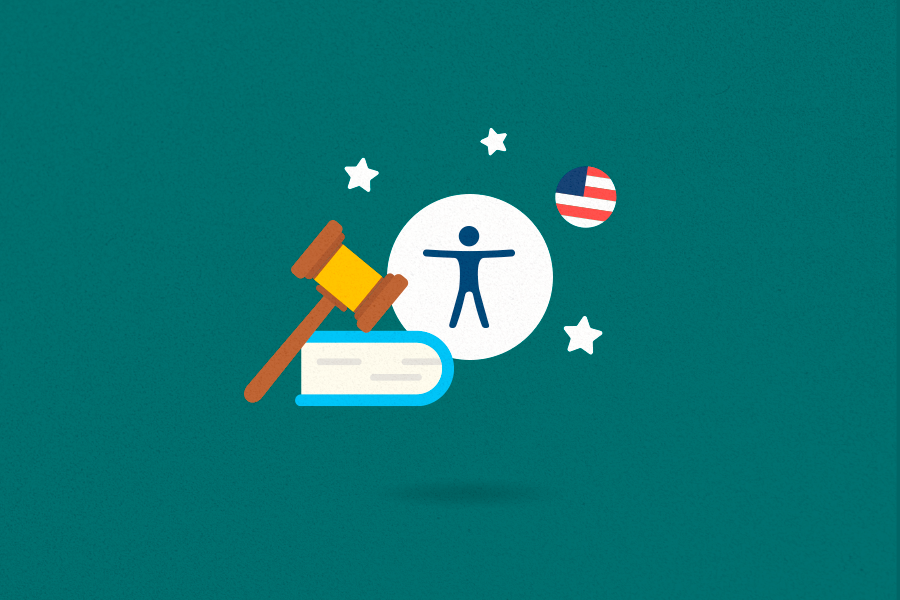
ADA Compliance: How to Make Your Website ADA Compliant

Do you know what ADA compliance is? Or what is it regarding? Did you know that your company is subject to a fine for not complying with ADA? That is what we are here to talk about!
What is ADA Compliance?
In the United States, there are more than 40 million people with disabilities that are facing many accessibility barriers everyday, in different contexts. Regarding the civil and accessibility rights of those with disabilities, in 1990, president George Bush signed into law the Americans with Disabilities Act (ADA).
The ADA compliance prohibits discrimination against people with disabilities, which also imply ensuring their inclusion in all means.
ADA is a guideline for private and public corporations to follow and guarantee accessibility. Besides promoting more self-determination, it is here to make sure they will have the opportunity to enjoy integration into economic, political, social, cultural, and educational mainstream of American society.
So, if you believe in inclusion, ADA compliance is also your dutty!
Is Ada Compliance Mandatory For Websites?
As the world is getting more and more technological as the years go by, unfortunately web accessibility is still a theme not discussed enough, especially in companies.
But the answer to this question is: yes! It is part of the ADA compliance to embrace digital accessibility on the websites. That’s the only way to guarantee that people with disabilities will have access to the content present on the page. Otherwise, they will still face many barriers that can complicate their navigation.
Who needs to follow ADA requirements?
Although there is a common misbelief that this only applies for large companies, in reality, ADA compliance is mandatory for all sizes of business and websites! That is the only way to be equitable and inclusive with your customers and employees! So, you must adapt to ADA requirements if your business identifies with:
- Government offices;
- Labor unions;
- Places of entertainment (movie theaters, theaters and concert halls);
- Restaurants and eating establishments;
- Retail stores;
- Large enterprises;
- Small and medium business of all types (stores, commercers facilities and ecommerces);
- Schools and other education institutions.
Who Is Exempt From Ada Compliance?
Even though most of the places and businesses must be ADA compliant, there are some exemptions. They are found in section 203, 206 and 2015 of the law:
203 General Exceptions – ADA Compliance: At section 4.1: “Limited Access Spaces and Machinery Spaces”. So, all spaces that have limited means of access. For example: ladders or very narrow passageways, and that are visited only by service personnel for maintenance, are exempted from all accessibility requirements.
On the top of that, websites connected to it are eligible for the exemption of ADA compliance and digital accessibility requirements. However, even when you could be exempt, you can still make your business ADA compliant and contribute to a more inclusive world!
Furthermore, there are a few businesses that are exempt from having to attain ADA compliance. Such as:
- Companies that only operates for twenty weeks in a year;
- Businesses with less than 14 employees;
- Private clubs;
- Religious establishments;
- Some employee working areas (usually related with repairs, maintenance etc).
What Happens If Your Website is not Ada Compliant?
Lawsuits! Yes, if your business, including the website, is not ADA compliant, it is at risk of getting sued. Small businesses are great targets of those fines, as most of them do not apply the accessibility standards required.
In addition, experts estimate that in 2020, the number of lawyers’ letters and processes was about 10,982. And kept growing through 2021, rising over 11.400 federal filings documented, which represents a 320% increase in eight years.
Through all this data, as well as by an official letter to legislators, the Department of Justice (DOJ) has proven the point that ADA compliance must be a priority for all sizes of businesses and websites.
What Are The ADA Guidelines for Websites?
By now you already know that ADA compliance must be a priority, if you do not want to be sued, as well as want to reach the public of people with disabilities. Then, the best recommendation is the WCAG 2.2 (Web Content Accessibility Guidelines).
This fulfilled several requirements for ADA compliance. It includes some principles, such as the ones listed below:
- Your visitors must be able to consume and understand all the content present on your website. Which means that all videos, images, texts, audios and tools, have to be accessible to people with disability.
- Your visitors must be capable of navigating through the pages and using all the features available.
- The most important thing to think is: “Do all my visitors have a good experience on my website? Even if they are navigating using assistive technologies?”
It is possible to build a beautiful, accessible and ADA compliant website!
Who Benefits From Web Accessibility?
Not only people with disabilities are benefiting from ADA compliance. Although they are the people that endup using it the most, also the elderly and even people that need it only for a period of time, are benefiting from accessibility. For example, if you are recovering from an eye surgery, screen readers can be useful for a while. Or if you broke an arm and are navigating with the help of some assistive technology.
But the hidden gold mine is that ADA compliance benefits also the businesses that attend to these requirements! That happens because when the brand is accessible to people with disabilities, you’re opening its doors to this public that is invisibilized for most of your market competitors! It is also very positive for the company’s branding, as it positions the brand as an inclusive player.
How Do I Make My Site Ada Compliant?
If you already understand that ADA compliance must be your goal, here is a good tip: become friends with the WCAG 2.2 guidelines! Learn and apply it, or make sure to hire an accessibility specialist developer. But, to keep it simple, here are some easy ways websites can solve accessibility issues:
Content and Design
Videos and images:
- Add ALT texts in all images, illustrations and vídeos of the website. This practice allows people with disabilities that use screen readers to hear the alternative descriptions, learning what is in the content.
- Add subtitles to all your videos. That is an accessible resource that benefits not only deaf and hard of hearing people, but also everyone that can not listen to the audio at the moment.
- Transcribe all the audio content. This way, people who are deaf and hard of hearing usually can understand contents that otherwise would not be accessible to them.
- Avoid transmitting messages with images. This is not accessible for blind and low vision people that use screen readers to navigate, even with ALTs, this is not ideal.
Color:
- Watch out for overly saturated colors! It can bother people with autism and other disabilities.
- Take care with high contrast. Ensure all the colors are comfortable to all people.
- Enable contrast and brightness customization. By doing so, you are allowing people to manage in the way that suits them best.
Fonts and texts:
- Use fonts with good readability. Take care with the fonts and sizes. Make it possible for everyone to read comfortably.
- Avoid complex sentences. Always think that part of your public could have intellectual disabilities, or even speak ASL (American Sign Language) as a mother language. So keep it simple!
Website
Layout:
- Ensure that your layout follows a logical and uncomplicated sequence. This is also a tip that benefits all publics, but especially people with intellectual disabilities.
- Ensure all controls are visible. All the controls needed to navigate through the page must be completely visible in the website.
CTA (call to action) and buttons:
- CTAs and other buttons must be very obvious for all users, so make sure it is saying exactly what they need to, and that it is guiding to the right page.
- Create a touch area of at least 44 pixels. This helps people with physical disabilities to click buttons easily.
There are plenty of other ways to start building a more accessible page. Having professional help is essential for a business committed to ADA compliance, just as much as studying more about it. You can always count on our blog to keep getting good information!


